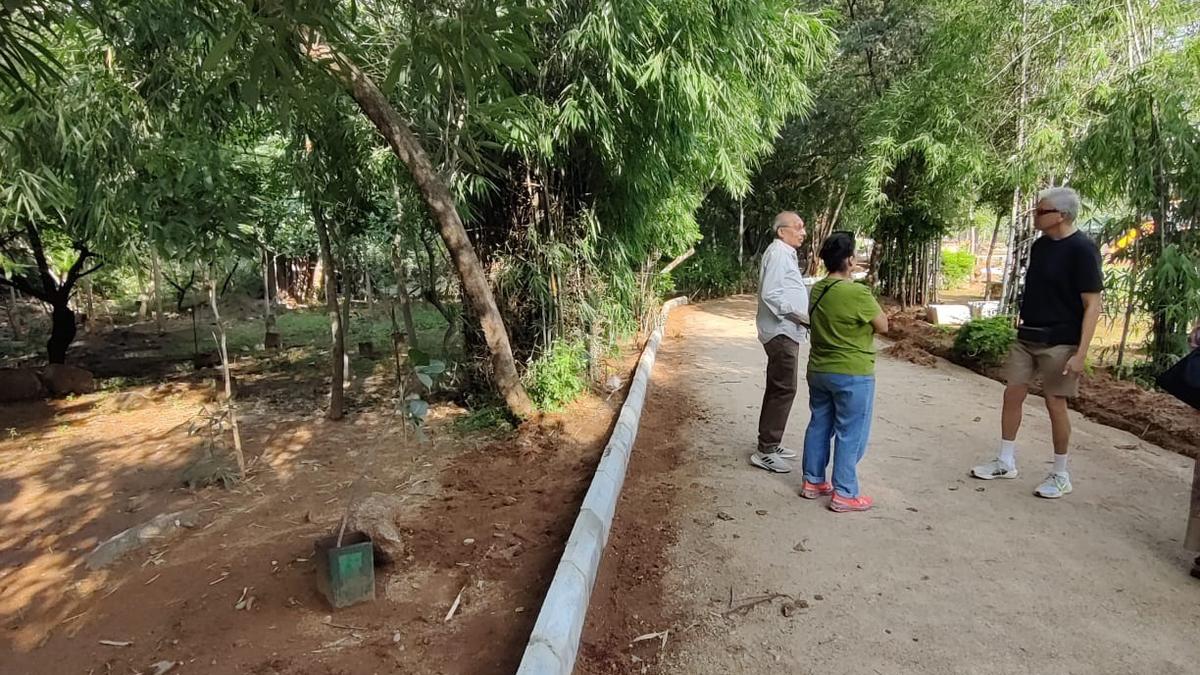
Two rows of cement blocks rose 10 inches above ground, linearly separating the walking track from the vegetation. A pile of the same blocks awaited their turn beside an excavator machine employed in trench digging work. These, together with heaps of cement all along the walking track at regular intervals, indicated that the work was far from finished inside the Kasu Brahmananda Reddy (KBR) National Park here.
Designed to be a distinct haven for wildlife in the centre of the metropolis, the KBR National Park is being steadily relegated in status to a routine walkers’ park, with hordes of feet thumping the ground twice a day, sending the variety of wildlife inhabiting the park scuttling away.
“We are creating separate lanes on both sides of the walking track marked off by these cement blocks, where hedge plants can be grown. They will look beautiful and walkers will enjoy them,” said the construction supervisor.
Patches of Duranta, a flowering plant, can be seen lining the track at several locations, giving an alien touch to the park where native species ought to be the only choice.
“They had tried this earlier and failed because hedges cannot survive in the shade of the huge trees already lining the path. Instead of forestry, the department has been doing all these non-forest activities to please VIP walkers,” said Kobita Das, an avid naturalist.
The cement barricades will put several species of small life to misery as they cannot manoeuvre the height, she pointed out.
“I had to physically lift a star tortoise and place it on the other side of the walking track recently, as it was unable to climb over the kerb,” Madan Saraf, a regular walker, shared.
The earth on the other side of the walking track was cleared of plants and topped with sand in preparation for the hedge plants. The sand brings along weed, the invasive growth of which hinders native varieties, thus affecting the biodiversity of the area, said Ms. Das.
“Earthworm casts which fertilise the soil were thrown away. Leaves, which should be left to mulch, have been removed. The park is not being managed as a forest. It is losing its wildlife character and becoming an urban walkers’ park,” lamented Asheesh Pittie, a well known birder.
Four gazebos, constructed two months ago, vouch for what Mr.Pittie said, as does the open air gym started seven years ago, against which several activists wrote to the Ministry of Environment, Forests & Climate Change pointing out that such activities are not permitted inside a national park under the Wildlife (Protection) Act, 1972.
Rocky embankments holding tin planters were placed on the thick soil layer spread over priceless sheet-rock, which is an integral part of the scrub jungle that KBR Park is.
“They plant everywhere, entirely spoiling the natural landscape. Scrub jungles dry out in summer, which is natural. But the gaps are planted after summer, which changes the character of the land. They are supposed to manage what naturally exists, not change it to a public park,” Mr.Pittie said.
Forest Range Officer in-charge of KBR National Park, Lakshmipathi Rao said every proposal for work inside the park gets approval from the Union Ministry of Environment, Forests & Climate Change and the National Board for Wildlife. He said the works for the construction of kerbs, gazebos and hedge plants also had the Central government’s nod.



